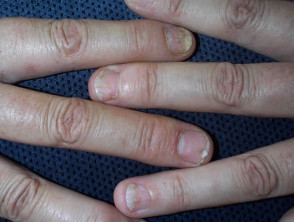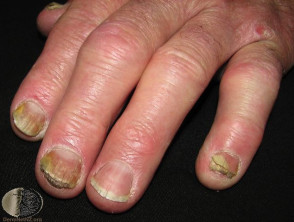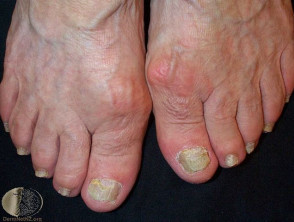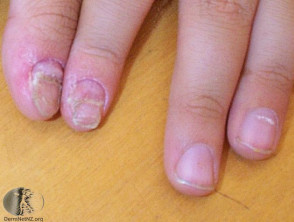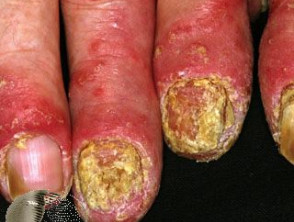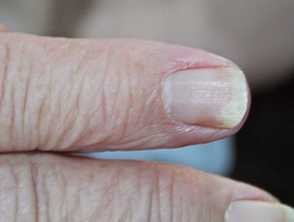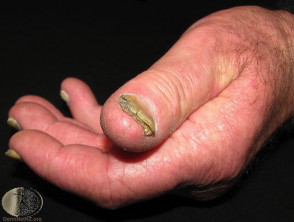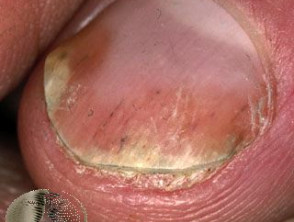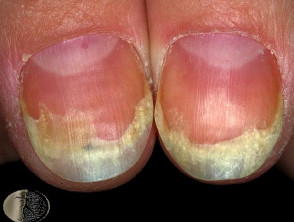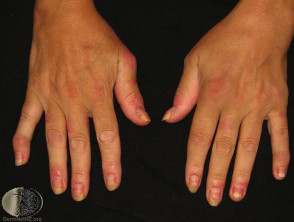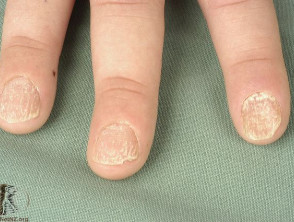What is nail psoriasis?
Nail psoriasis, also known as psoriatic nail dystrophy, is due to psoriasis involving the nail matrix or nail bed, resulting in specific and non-specific clinical changes in the nail.
Nail psoriasis
Who gets nail psoriasis?
Nail psoriasis affects 90% of patients with chronic plaque psoriasis at some time in their life. It is more common in adults with a prevalence of up to 80%, compared to children in whom it has been reported in 7–13%. In the absence of skin or joint disease, psoriatic nail disease has been described in 5–10% of adults.
Psoriatic nail disease may be a risk factor the development of psoriatic arthritis and is often associated with prolonged severe cutaneous psoriasis.
Nail psoriasis can affect all races and age groups, and both sexes, although a male predominance has been reported in one large case series.
What causes nail psoriasis?
Psoriasis is a multifactorial systemic disease including inflammation and epidermal hyperproliferation.
Nail psoriasis can involve the nail bed, nail matrix, hyponychium, and nail folds.
Theories include:
- Activation of the antimicrobial peptide LL-37 by Candida and the cytokine overflow theory
- Increased expression of interleukin(IL)-10 in the affected nail bed compared to downregulation of IL-10 in psoriatic skin lesions
- Koebnerisation of psoriasis in onychomycosis or nail trauma.
What are the clinical features of nail psoriasis?
Fingernails and toenails can be affected by nail psoriasis.
Psoriatic nail dystrophy can cause tenderness and pain, altered sense of fine touch, and difficulty picking up or manipulating objects such as shoelaces or buttons.
Clinical signs of nail matrix involvement
- Pitting
- Leukonychia
- Red spots in lunule
- Onychorrhexis (longitudinal nail ridge, split, or fissure)
- Beau lines (transverse lines and ridges)
- Nail crumbling
Signs of psoriatic nail matrix involvement
Clinical signs of nail bed involvement
- Oil-drop sign and salmon patch
- Onycholysis — typically with a pink zone proximally
- Subungual hyperkeratosis
- Splinter haemorrhages under the distal third of the nail plate
Signs of psoriatic nail bed involvement
Other clinical signs of psoriatic nails
- Paronychia due to periungual psoriasis
- Acrodermatitis continua of Hallopeau
- Twenty-nail dystrophy
Psoriatic nail dystrophy
[see also Nail psoriasis images]
What are the complications of nail psoriasis?
- Secondary onychomycosis in the damaged nail plate
- Psychosocial effects impacting social relationships and work-related activities
- Association with psoriatic arthritis and metabolic syndrome
How is nail psoriasis diagnosed?
Nail psoriasis is usually diagnosed clinically in a patient with psoriatic arthritis and/or cutaneous psoriasis.
The severity of nail psoriasis can be estimated using the Nail Psoriasis Severity Index (NAPSI) in which each nail is divided into quadrants and scored for clinical signs to come up with a numerical score.
Nail clippings for fungal microscopy and culture should be taken as onychomycosis may precede or complicate psoriatic nail dystrophy, and immunosuppressive medications may be used in treatment.
A proximal nail matrix biopsy is occasionally needed to confirm the diagnosis of nail psoriasis, particularly in the absence of signs of psoriasis elsewhere or where only a single nail is affected and a tumour cannot be excluded by other means. Biopsy can lead to permanent nail deformity.
What is the differential diagnosis for nail psoriasis?
- Onychomycosis
- Nail trauma
- Lichen planus of the nail
- Parakeratosis pustulosa
What is the treatment for nail psoriasis?
General measures
- Minimise nail trauma, keep affected nails short
- Treat associated onychomycosis first for at least three months
Specific measures
- Topical treatments
- Topical steroids — betamethasone dipropionate, clobetasol propionate
- Topical calcipotriol
- Topical calcineurin inhibitors
- Systemic treatments
- Methotrexate
- Acitretin
- Biological agents for psoriasis — infliximab, adalimumab, etanercept, ustekinumab
- Novel small molecules — apremilast, tofacitinib [see Janus kinase inhibitors]
- Nonpharmacological treatments
What is the outcome for nail psoriasis?
Nail psoriasis has a variable response to treatment. The visible response may take weeks or months due to slow growth of the nail plate, and relapses are common.
Psoriatic nail disease can fluctuate in severity over time and can resolve spontaneously.
